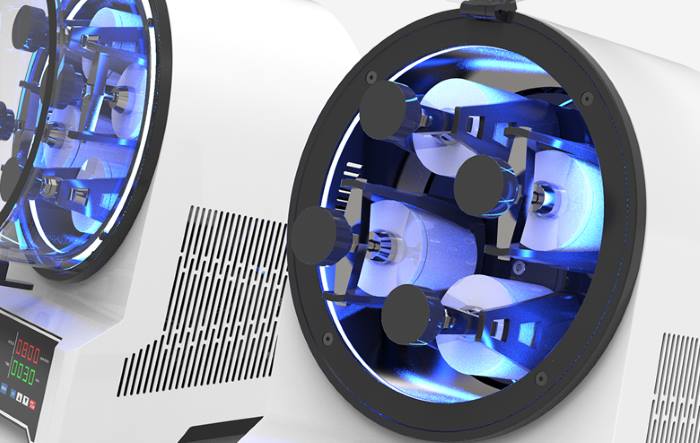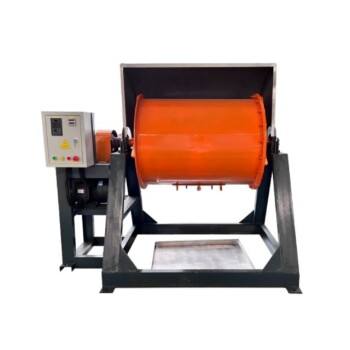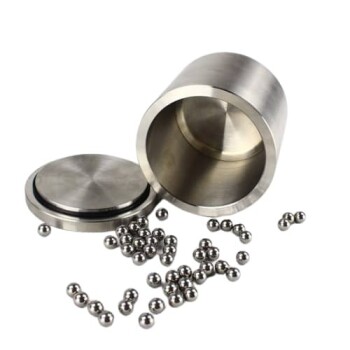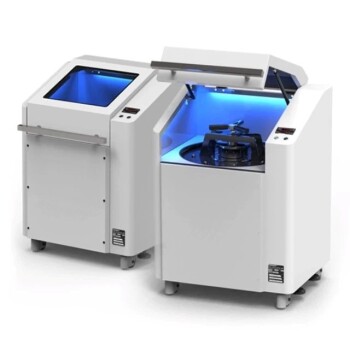
Milling Equipment
Laboratory Horizontal Planetary Ball Mill Milling Machine
Item Number : KT-P400H
Price varies based on specs and customizations
- Materials input size
- < 2 mm
- Materials output size
- 0.1-20 um
- Processing volume
- < 400 ml
- Grinding jar speed
- 0-900 r/min
- Number of grinding jar
- 4 pcs
Shipping:
Contact us to get shipping details Enjoy On-time Dispatch Guarantee.
Why Choose Us
Easy ordering process, quality products, and dedicated support for your business success.
Introduction
In sample processing, the uniformity of the sample results is an important indicator, but there is a common phenomena for samples to deposit during the grinding process. KT-P400H is a ball mill that performs planetary motion on the Y surface , therefore it solves the problem of sample deposition to a certain extent and improves the uniformity of sample results.
KT-P400E is one desktop multi-directional planetary ball mill. The movement of the planetary disc in the 360° position of the X and Y space is a unique feature of this product, which makes it have more excellent grinding and mixing capabilities. In terms of processing results, use safety, comfort, and convenience, it will bring users a unique experience.
Applications
The Horizontal Planetary Ball Mill is a versatile and high-performance tool primarily used in laboratory settings for the grinding and synthesis of materials down to ultrafine and nano-sized particles. This equipment is particularly effective in scientific research and development, where precise control over particle size and material properties is crucial. The applications of Horizontal Planetary Ball Mills span across various fields, including materials science, pharmaceuticals, and nanotechnology.
- Materials Synthesis: Used for mechanical alloying and synthesis of complex materials, including ceramics, composites, and metallic alloys.
- Pharmaceutical Preparation: Ideal for grinding pharmaceutical compounds to fine powders, essential for drug formulation and improving bioavailability.
- Nanomaterial Production: Effective in producing nano powders of 2 to 20 nm in size, crucial for applications in electronics, coatings, and catalysts.
- Explosives Blending: Utilized in the blending of explosives, where uniform mixing and particle size are critical for performance and safety.
- Environmental Remediation: Can be used to prepare materials for environmental applications, such as adsorbents for water purification or catalysts for pollution control.
- Energy Storage: Useful in the preparation of materials for advanced energy storage solutions, such as hydrogen storage in powder form.
- Scientific Research: Essential tool in academic and industrial research labs for the investigation of new materials and the study of mechanical activation of chemical reactions.
Features
The Horizontal Planetary Ball Mill is a high-performance tool designed for routine laboratory work, offering a range of features that enhance its efficiency and effectiveness in grinding sample materials to very small sizes. This equipment is particularly beneficial for researchers and scientists who require precise and uniform fine powders for their experiments and product development. Here are the key features that make the Horizontal Planetary Ball Mill a standout choice:
- Special Gear Design for Low Noise and Vibration: This feature ensures a quieter operation and minimal vibration, which is crucial for maintaining a stable environment in sensitive laboratory settings.
- LCD Control Panel: The intuitive LCD control panel allows for easy monitoring and adjustment of settings, enhancing user convenience and control over the milling process.
- Safety Mechanism: Safety is paramount in laboratory environments. This mill includes a safety mechanism that prevents accidental operation and ensures the protection of both the equipment and the user.
- Stable Rotation Speed: The mill's stable rotation speed ensures consistent grinding results, which is essential for achieving uniform particle sizes.
- Reliable Heavy-Duty Design: Built to withstand rigorous use, the heavy-duty design of this mill guarantees durability and longevity, making it a cost-effective choice for long-term use.
- Programmable Milling Segment**: The ability to program specific milling segments allows for customized grinding cycles, which is beneficial for achieving specific particle sizes and distributions.
- Customized Power Supply: With options for 110V, 220V, or 380V, the mill can be adapted to different power supply requirements, making it versatile for various laboratory settings worldwide.
These features collectively enhance the functionality and efficiency of the Horizontal Planetary Ball Mill, making it an indispensable tool for laboratories focused on material science, nanotechnology, and other fields requiring high-precision milling.
Detail & Parts



Advantages
The Horizontal Planetary Ball Mill offers a range of significant advantages for laboratory work, particularly in the synthesis and grinding of materials down to ultrafine and nano-sized particles. Here are some of the key benefits:
- High Grinding Efficiency: The horizontal configuration of the planetary ball mill enhances the grinding efficiency by allowing the materials to be ground rapidly, even those with high hardness and viscosity. This setup ensures that the product fineness can reach sub-micron levels, making it ideal for producing nano powders.
- Advanced Mechanical Energy Transfer: The unique design of the horizontal planetary ball mill, where the rotation directions of the bowl and turn disc are opposite, results in a synchronized alternation of centrifugal forces. This mechanism leads to friction and impact forces that are significantly higher than those in traditional ball mills, facilitating a more effective size reduction.
- Versatility in Applications: This type of ball mill is highly versatile and can be used for grinding a wide variety of materials, including magnetic materials, inorganic non-metallic materials, organic chemical materials, and biomedical materials. This versatility makes it a valuable tool in multiple scientific and industrial fields.
- Precise Control and High Precision: The horizontal planetary ball mill provides high precision in the grinding process, allowing for fine control over the particle size and uniformity of the ground materials. This precision is crucial for applications that require specific particle sizes and distributions.
- Compact and User-Friendly Design: Compared to common ball mills, planetary ball mills are smaller and more compact, making them ideal for laboratory settings where space is limited. Additionally, they are designed for ease of use, requiring minimal maintenance and operational attention.
- Cost-Effective and Efficient: The process of ball milling in a planetary setup is not only efficient but also cost-effective. It requires less time and fewer resources compared to other milling methods, yet it can produce nano powders of 2 to 20 nm in size, depending on the speed of rotation.
- Generation of Crystal Defects: The mechanical energy applied during the milling process can produce crystal defects, which can be beneficial for certain applications, such as altering the properties of materials for specific uses in electronics or materials science.
These advantages make the Horizontal Planetary Ball Mill a high-performance all-rounder in routine laboratory work, particularly for researchers and scientists looking to develop innovative products through the synthesis of ultrafine materials.
Functions
- Continuous and intermittent operation
- Emergency stop
- Timing
- Power failure memory
- Overload and dangerous operation protection
Technical specifications
| Grinding principle | Impact & friction force |
| Suitable materials | Small and medium-low hardness; brittle; dry or wet |
| Materials input size | < 2 mm |
| Materials output size | 0.1-20 um |
| Processing volume | < 400 ml |
| Grinding jar speed | 0-1000 r/min |
| Grinding jar material | Tungsten carbide; Ceramic; Agate; Stainless steel; Harden steel; Nylon, etc. |
| Number of grinding jar | 4 pcs |
| Grinding jar volume | 100 ml |
| Grinding ball material | Tungsten carbide; Zirconia; Alumina; Agate; Stainless steel, etc. |
| Motor power | 100-120V/200-240V AC ,50-60Hz,150W |
| Net weight | 35 kg |
| Dimensions | L300 * W350 * H420 mm |
| Protection level | IP65 |
| Quality standards | CE |
Warnings
Operator safety is the top important issue! Please operate the equipment with cautions. Working with inflammable& explosive or toxic gases is very dangerous, operators must take all necessary precautions before starting the equipment. Working with positive pressure inside the reactors or chambers is dangerous, operator must fellow the safety procedures strictly. Extra caution must also be taken when operating with air-reactive materials, especially under vacuum. A leak can draw air into the apparatus and cause a violent reaction to occur.
Designed for You
KinTek provide deep custom made service and equipment to worldwide customers, our specialized teamwork and rich experienced engineers are capable to undertake the custom tailoring hardware and software equipment requirements, and help our customer to build up the exclusive and personalized equipment and solution!
Would you please drop your ideas to us, our engineers are ready for you now!
FAQ
What Is A Laboratory Ball Mill?
What Is A Planetary Ball Mill?
What Are The Applications Of A Laboratory Ball Mill?
What Are The Main Applications Of Planetary Ball Mills?
What Are The Main Types Of Laboratory Ball Mills?
What Are The Key Features Of Planetary Ball Mills?
What Is The Working Principle Of A Laboratory Ball Mill?
What Are The Advantages Of Using A Planetary Ball Mill?
What Are The Advantages Of Using A Laboratory Ball Mill?
What Types Of Planetary Ball Mills Are Available?
What Materials Can Be Processed Using A Laboratory Ball Mill?
How Does The Automatic Reversal Mechanism In Planetary Ball Mills Work?
What Are The Key Features Of A High-energy Planetary Ball Mill?
What Makes Planetary Ball Mills Suitable For Small Particle Samples?
What Is The Difference Between A Planetary Ball Mill And A Vibratory Ball Mill?
4.9 / 5
The Horizontal Planetary Ball Mill from KINTEK SOLUTION is a top-notch piece of equipment. It's incredibly efficient and produces consistent results.
4.8 / 5
The mill is built with high-quality materials and is very durable. It's also easy to operate and maintain, which saves me a lot of time.
4.7 / 5
I'm impressed with the speed of delivery from KINTEK SOLUTION. I received my Horizontal Planetary Ball Mill within a week of ordering it.
4.9 / 5
The mill is very versatile and can be used for a variety of applications. I've used it to grind a variety of materials, and it's always performed flawlessly.
5.0 / 5
The Horizontal Planetary Ball Mill is a great value for the money. It's a high-quality piece of equipment that's built to last.
4.8 / 5
The mill is very easy to use. The control panel is intuitive and easy to understand, and the mill operates smoothly and quietly.
4.7 / 5
I'm very happy with the Horizontal Planetary Ball Mill from KINTEK SOLUTION. It's a great piece of equipment that has helped me to improve my research.
4.9 / 5
The mill is very durable and has held up well to heavy use. I've been using it for over a year now and it's still going strong.
5.0 / 5
The Horizontal Planetary Ball Mill is a great investment. It's a high-quality piece of equipment that will last for years to come.
4.8 / 5
I'm very impressed with the technological advancement of the Horizontal Planetary Ball Mill. It's a very sophisticated piece of equipment that can be used for a variety of applications.
4.7 / 5
The mill is very easy to maintain. It's easy to clean and the parts are easy to replace.
4.9 / 5
I highly recommend the Horizontal Planetary Ball Mill from KINTEK SOLUTION. It's a great piece of equipment that will improve your research.
5.0 / 5
The mill is very reliable. It's never broken down on me and it always produces consistent results.
4.8 / 5
The Horizontal Planetary Ball Mill is a great addition to my lab. It's a powerful and versatile piece of equipment that has helped me to improve my research.
REQUEST A QUOTE
Our professional team will reply to you within one business day. Please feel free to contact us!
Related Products

High Energy Planetary Ball Mill Milling Machine for Laboratory
The biggest feature is that the high energy planetary ball mill can not only perform fast and effective grinding, but also has good crushing ability

High Energy Planetary Ball Mill for Laboratory Horizontal Tank Type Milling Machine
KT-P4000H uses the unique Y-axis planetary motion trajectory, and utilizes the collision, friction and gravity between the sample and the grinding ball to have a certain anti-sinking ability, which can obtain better grinding or mixing effects and further improve the sample output.

Mini Planetary Ball Mill Machine for Laboratory Milling
Discover the KT-P400 desktop planetary ball mill, ideal for grinding and mixing small samples in the lab. Enjoy stable performance, long service life, and practicality. Functions include timing and overload protection.

High Energy Planetary Ball Mill Machine for Laboratory Horizontal Tank Type
The KT-P2000H uses a unique Y-axis planetary trajectory, and utilizes the collision, friction and gravity between the sample and the grinding ball.

Laboratory Planetary Ball Mill Rotating Ball Milling Machine
KT-P400E is a desktop multi-directional planetary ball mill with unique grinding and mixing capabilities. It offers continuous and intermittent operation, timing, and overload protection, making it ideal for various applications.

High Energy Planetary Ball Mill Milling Machine for Laboratory
Experience fast and effective sample processing with the F-P2000 high-energy planetary ball mill. This versatile equipment offers precise control and excellent grinding capabilities. Perfect for laboratories, it features multiple grinding bowls for simultaneous testing and high output. Achieve optimal results with its ergonomic design, compact structure, and advanced features. Ideal for a wide range of materials, it ensures consistent particle size reduction and low maintenance.

Laboratory Planetary Ball Mill Cabinet Planetary Ball Milling Machine
The vertical cabinet structure combined with ergonomic design enables users to obtain the best comfortable experience in standing operation. The maximum processing capacity is 2000ml, and the speed is 1200 revolutions per minute.

High-Energy Omnidirectional Planetary Ball Mill Machine for Laboratory
The KT-P2000E is a new product derived from the vertical high-energy planetary ball mill with a 360°rotation function. The product not only has the characteristics of the vertical high-energy ball mill, but also has a unique 360°rotation function for the planetary body.

Stainless Steel Laboratory Ball Mill for Dry Powder and Liquid with Ceramic Polyurethane Lining
Discover the versatile stainless steel dry powder/liquid horizontal ball mill with ceramic/polyurethane lining. Ideal for ceramic, chemical, metallurgical, and building materials industries. High grinding efficiency and uniform particle size.

High-Energy Omnidirectional Planetary Ball Mill Milling Machine for Laboratory
The KT-P4000E is a new product derived from the vertical high-energy planetary ball mill with a 360° swivel function. Experience faster, uniform, and smaller sample output results with 4 ≤1000ml ball mill jars.

Laboratory Four-Body Horizontal Jar Mill
The four-body horizontal tank mill ball mill can be used with four horizontal ball mill tanks with a volume of 3000ml. It is mostly used for mixing and grinding laboratory samples.

Laboratory Ten-Body Horizontal Jar Mill for Lab Use
The Ten-body horizontal jar mill is for 10 ball mill pots (3000ml or less). It has frequency conversion control, rubber roller movement, and PE protective cover.

Laboratory Ball Mill Jar Mill with Metal Alloy Grinding Jar and Balls
Grind and mill with ease using metal alloy grinding jars with balls. Choose from 304/316L stainless steel or tungsten carbide and optional liner materials. Compatible with various mills and features optional functions.

High Energy Vibratory Ball Mill for Lab Use
The high-energy vibrating ball mill is a high-energy oscillating and impacting multifunctional laboratory ball mill. The table-top type is easy to operate, small in size, comfortable and safe.

Laboratory Jar Ball Mill with Alumina Zirconia Grinding Jar and Balls
Grind to perfection with alumina/zirconia grinding jars and balls. Available in volume sizes from 50ml to 2500ml, compatible with various mills.

Laboratory Micro Tissue Grinding Mill Grinder
KT-MT10 is a miniature ball mill with a compact structure design. The width and depth are only 15X21 cm, and the total weight is only 8 kg. It can be used with a minimum 0.2ml centrifuge tube or a maximum 15ml ball mill jar.

Laboratory Disc Cup Vibratory Mill for Sample Grinding
The vibrating disc mill is suitable for non-destructive crushing and fine grinding of samples with large particle sizes, and can quickly prepare samples with analytical fineness and purity.

Lab Vibration Mill
Vibration Mill for Efficient Sample Preparation, Suitable for Crushing and Grinding a Variety of Materials with Analytical Precision. Supports Dry / Wet / Cryogenic Grinding and Vacuum/Inert Gas Protection.
Related Articles

Advantages of Planetary Ball Mill in Laboratory Applications
Discover the advantages of using planetary ball mills in laboratory settings. Learn about its ability to produce fine powder, suitability for toxic materials, wide range of applications, continuous operation, and usage for milling abrasive materials. Explore how planetary ball mills differ from traditional milling machines and their function in creating ultrafine and nano-sized materials.

Maximizing Grinding Efficiency: The Power of Planetary Ball Mills
Discover why planetary ball mills offer higher grinding efficiency than ordinary ball mills. Learn about the technology behind their high-performance all-round capabilities. Find out the key factors influencing the productivity and specific energy consumption of ball mills.

Features of Different Laboratory Mills: An Overview
Laboratory mills are specialized machines used to reduce non-homogenous batch samples into smaller, representative samples that are more uniform in composition.

Planetary Ball Mills: Research Tools for Efficient Mixing and Nanoscale Grinding
Planetary ball mills are indispensable tools in modern laboratories, serving a crucial role in the mixing, fine grinding, and preparation of small samples. These mills are particularly adept at dispersing nanomaterials and facilitating the development and small-scale production of high-tech materials.

Disc / Cup Vibratory Mill: A Comprehensive Guide for Laboratory Experts
Discover the world of Disc / Cup Vibratory Mills! This comprehensive guide provides an in-depth understanding of their types, working principles, advantages, and applications in various industries, including pharmaceuticals, chemicals, and food processing.

Choosing the Best Material for Ball Mill: Essential Factors and Recommendations
Discover the best material for ball mill applications and grinding success. Learn about the features and benefits of stainless steel, ceramic, agate, and tungsten carbide media. Find out how to ensure grinding success and the ideal grinding jars and media for planetary ball milling. Explore the applications of ball mills and the advantages of high-energy ball mills for ultra-fine particles.

Disc / Cup Vibratory Mill: A Comprehensive Guide to Its Functions and Applications
Discover the world of Disc / Cup Vibratory Mills with our in-depth guide. Learn about their working principles, applications, advantages, and key features. Explore the various types of vibratory mills and their suitability for different industries.

How to Use FTIR Pellet Press to Prepare Samples for Analysis
Fourier Transform Infrared (FTIR) spectroscopy is a powerful analytical technique used to identify and quantify chemical compounds in a wide range of samples. FTIR analysis requires the sample to be in the form of a pellet, which is prepared by compressing the sample with a suitable matrix material.

Comprehensive Guide to Filter Press Pilot Testing
Filter press pilot testing serves the purpose of collecting data necessary for accurately sizing a full-scale filter press system. This data includes various parameters such as cake solids, cake density, total processing time, processing time for each step, slurry feed solids, slurry pH, chemical conditioning dosages, and maximum operating pressure for each process step. Additionally, other data like filtrate suspended solids, slurry pH, and specific chemical analysis required by the process may also be collected.

Working Principle of Vertical Ball Mill : Impact, Attrition, and Size Reduction
Discover the working principle of vertical ball mills through impact and attrition mechanisms. Learn how materials like iron ore and ceramics are ground to a fine medium. Explore the construction, operations, advantages of vertical mills in this detailed guide.

It’s Not a 'Bad Batch': Why Your High-Strength Rubber Parts Are Failing Prematurely
Frustrated by rubber components failing? The cause is rarely a 'bad batch.' Learn the real reason and how to select the right material every time.

Understanding Cold Isostatic Pressing (CIP) and Hot Isostatic Pressing (HIP) in Powder Metallurgy
Cold Isostatic Pressing (CIP) and Hot Isostatic Pressing (HIP) are two powder metallurgy techniques used to produce dense and high-quality metal components.